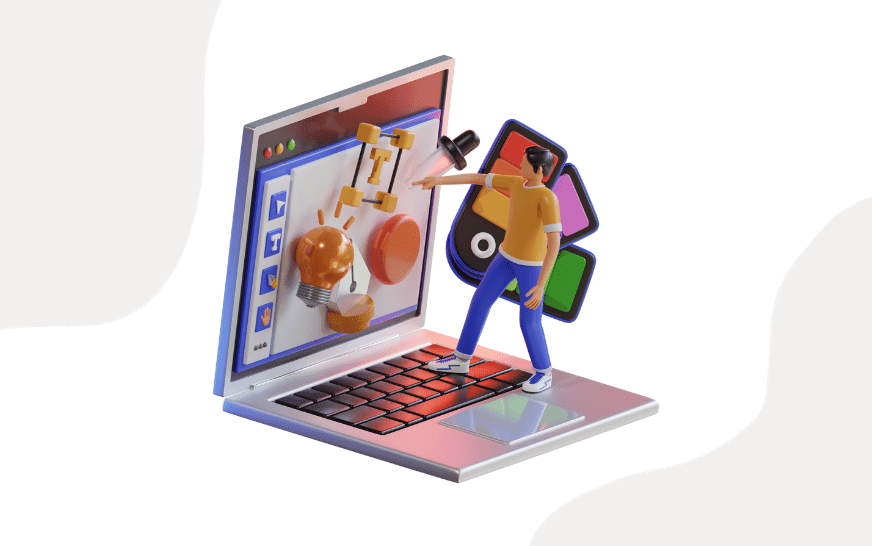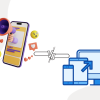The Importance of Illustration in Web Design
Imagine stepping into a dull room with monotone walls and not a single trace of art or decoration. You’d probably find it uninspiring and dull, right? Now, think of a website in the same way. What’s the secret ingredient that can transform a bland website into a captivating digital masterpiece?
There is a simple answer to this question: Illustrations. Unlike in the past, web design today isn’t just about functionality. It’s about storytelling, emotion, and that indescribable “wow” factor. There’s something magical about illustrations.
Let’s take a look at “The Importance of Illustration in Web Design” and see what it means. We’ll dive into web design in this captivating journey and discover how illustrations are a crucial part of this journey. If you’re a web designer, content creator, or just someone who loves the internet, this journey will reveal the magic that happens when imagination meets technology. Find out how illustrations make the digital world come alive and create a sense of connection and wonder.
What Is Illustration in Web Design?
In the world of web design, illustration is the art of creating custom graphics, either by hand or digitally, to infuse a website with personality and uniqueness. Unlike stock images or generic icons, these illustrations are tailor-made to fit a website’s distinct character.
Web design illustrations have the power to adapt to various contexts and convey a wide range of messages. They can be imaginative and playful for a children’s website or exude professionalism and style for a corporate site. Their versatility allows them to seamlessly integrate into different themes while maintaining their identity.
Essentially, web design illustrations are the heart and soul of a website. They communicate ideas, evoke emotions, and guide users through the digital journey. They create a unique, engaging, and memorable experience, making your website more than just a collection of web pages.
The Impact of Illustration on User Experience
Now, here’s where it gets exciting. Illustrations aren’t just there to make your site look pretty, they play a pivotal role in the user experience. Imagine explaining a complex concept without words. Tough, right? But with the right illustration, you can convey ideas and emotions effortlessly. Illustrations are the superheroes of web design, making a website’s user experience remarkable in several ways. Let’s look at some of the important things illustration does for user experience.
Visual Engagement
Illustrations are the attention grabbers of your website. In a world where we’re overloaded with information, the visual is the most effective. They instantly draw the eye, making visitors stop and take notice. It’s like having a friendly face in a crowded room, it’s hard to resist.
When users land on a website filled with captivating illustrations, they’re more likely to stay and explore. Why? Because our brains are wired to love visuals. They’re processed faster than text, making your website instantly digestible.
Storytelling
Think of web design illustrations as the storytellers of your digital space. They breathe life into your content, transforming it from boring text into captivating stories. They evoke emotions, convey complex ideas, and guide users seamlessly through your website.
It’s like having a tour guide on an adventure – they make the journey enjoyable and effortless. Instead of just reading words, users are engaged in an immersive experience.
Brand Personality
Your website isn’t just an online presence; it’s a reflection of your brand’s personality. It’s like your brand’s avatar, representing its values, style, and mission. Illustrations play a pivotal role in this. They are your brand’s visual ambassadors, conveying your identity and making a memorable first impression. They define the tone – whether it’s playful, professional, or quirky. They create an emotional connection, turning visitors into loyal fans. Think of them as the costumes and props that shape your brand’s character.
Navigational Ease
Navigating a complex website can be like navigating a dense forest without a map. This is where illustrations come to the rescue. They act as signposts on the digital highway, guiding users effortlessly. Icons indicate where to click, infographics simplify complex data, and custom illustrations provide context. They make the journey smooth, preventing users from getting lost in a maze of information. It’s like having a GPS for your website, ensuring visitors reach their destination without frustration.
Information Simplification
Ever tried to make sense of a wall of text? It can be difficult. But present that same information through illustrations, and suddenly it becomes a breeze to understand. Infographics, for instance, break down complex data into manageable bits, making your content more accessible. They’re like translators for your information, converting it into a language that everyone can understand.
Emotional Impact
Illustrations have the incredible power to evoke emotions. They can make users feel joy, curiosity, or trust. Emotions are a gateway to building a strong connection with your audience. Just like a heartfelt smile or a warm handshake in the real world, illustrations create a positive emotional impact in the digital realm. They add a human touch to your website, making it relatable and memorable.
Accessibility
Good web design is inclusive web design. Well-crafted illustrations enhance accessibility by providing visual cues and context. This benefits all users, including those with disabilities. They can aid in conveying information, guiding users, and making your site more welcoming to everyone. Accessibility isn’t just a legal requirement, it’s a fundamental aspect of a user-friendly website.
Increased Stay Time
Engaging illustrations keep visitors on your site longer. When users are captivated by visuals, they’re more likely to explore further, reducing bounce rates. This sends a positive signal to search engines that your content is valuable and keeps visitors coming back for more. It’s like the secret sauce that makes users linger, ensuring they get the most out of your website.
SEO Benefits of Using Illustrations
Illustrations aren’t just pretty additions to your website, they hold substantial SEO benefits.
- First, they reduce bounce rates by engaging visitors, keeping them on your site longer. This signals to search engines that your content is valuable.
- Second, illustrations increase dwell time, a metric search engines consider for content quality. Engaging visuals encourages users to explore, ultimately improving SEO.
- Third, visuals enhance the overall user experience. Satisfied users are more likely to return and engage further, which search engines appreciate.
- Fourth, well-optimized images can reduce page load times, a critical SEO factor. Additionally, providing descriptive alt text and filenames for your illustrations helps search engines understand their context.
In short we can say, web design illustrations are powerful SEO tools. They lower bounce rates, increase dwell time, enhance user experience, optimize page load times, and offer SEO potential through informative text. As SEO allies, they enhance the visibility and ranking of your website.
Types of Illustrations Used in Web Design
Let’s take a closer look at the diverse world of web design illustrations. Think of these as the tools in a designer’s toolbox, each with its unique role in creating a stellar web experience.
Icons – The Signposts of Your Website:
Icons are the unseen heroes of web design. They’re like the road signs that guide users through your digital world. You know those little magnifying glass icons that say “search” or the envelope for “email”? That’s them. Icons provide instant recognition and direction, helping users find what they’re looking for without getting lost in the vast online world.
Infographics – Visual Storytellers
Now, if icons are the signposts, infographics are the captivating storytellers. They’re like the graphic novels of the web design world. Infographics take complex data and transform it into bite-sized, easy-to-understand visuals. They’re perfect for explaining complex processes, presenting statistics, or simplifying information into a visual narrative that anyone can follow.
Custom Artwork – Where Your Brand Shines
Custom illustrations are like a distinct brush stroke of an artist, tailored to match your brand’s style, values, and message. They are not just visuals, they’re a reflection of your brand’s identity, adding that extra layer of personalization to your website.
So, whether you’re using icons to guide visitors, infographics to tell a compelling story, or custom artwork to make your brand shine, illustrations in web design are the versatile tools that help you create a visually engaging and memorable digital experience.
Best Practices for Using Illustrations in Web Design
When it comes to using illustrations in web design, a few key practices can make all the difference:
- Your brand is the star of the show, so make sure your illustrations are consistent in style, color, and messaging.
- Think of illustrations as supporting actors in a movie. They should complement your content, not overshadow it.
- Illustrations should look great on all screens, regardless of the size. They should adapt seamlessly, like costumes that fit all actors.
- Illustrations should clarify, not confuse. Use them to simplify complex ideas or provide visual cues that aid understanding.
- Use illustrations to guide users and emphasize important points. They serve as road signs on a journey, helping users find their way around your site.
- Optimize image file sizes to ensure fast page loading times. Slow loading sites frustrate users and negatively affect SEO.
- Analyze how your illustrations contribute to user engagement and SEO on a regular basis. Adjust and refine as needed.
Warping Up
In the world of web design, user experience is king. It’s the difference between a visitor who clicks away in frustration and one who becomes a loyal customer. Illustrations are your secret weapon in creating an exceptional user experience.
So, the next time you’re revamping your website or creating a new one, don’t underestimate the power of illustrations. They’re not just pretty pictures; they’re the storytellers, the engagement boosters, and the brand shapers. They’re the ingredients that transform your website from a digital space into an unforgettable experience.






